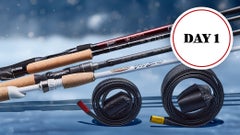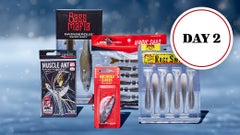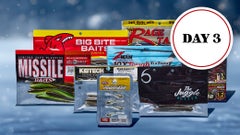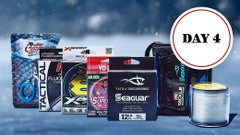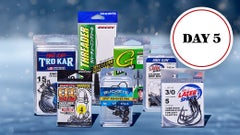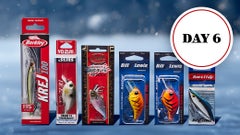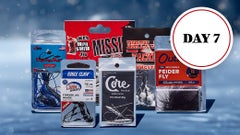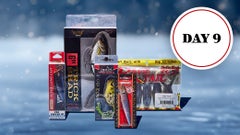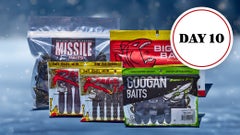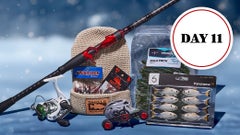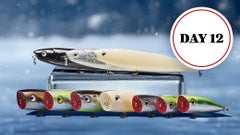Mike McClelland Wins BASS Table Rock Lake
Mike McClelland's Winning Pattern, Baits & Gear
Table Rock has a strong reputation for being a pattern lake, meaning if someone's able to catch fish in 8 feet of water near a channel swing, chances are similar areas around the lake will harbor fish. "One thing that I was frustrated with is we never had sun and wind in practice," he said. "That's when I catch them best on the jerkbait, but it was great actually that the conditions ended up like they did in practice because we had a little bit of everything. We had cold and relatively slick conditions with a little breeze to windy and blue bird skies. I felt like I knew what to do in all scenarios. "I never got to cut it loose with the sun and wind, though. If we'd have had that, the jerkbait bite would've been even more incredible." He said there was a section of the lake coming into the tournament that he wanted to fish, but wound up bypassing it altogether after getting on a couple patterns further up the lake. "Typically, the White River is the earlier arm that turns on and by this time of year, usually it starts to go south," he said. "I had wanted to fish from Kimberling City to the dam, but I couldn't make it work. I spent some time in the White, probably 1 and three-quarters days. Every day I would put in by the dam and fish up to the White." On the final day of practice, he put in at Shell Knob well up the White River arm, but wasn't enthused by what he found after a couple hours. He took out and drove to Kimberling City and put in there. "That's when I found out they were biting in that area," he said. "The first 2 days I'd gone through there and hadn't gotten any bites. That last day is when I got like seven bites in Fisher Creek. "The last day of practice turned out to be key. I actually fished further up the White than I ever intended on going."
Competition:
The decision to focus on that section of lake turned out to be crucial as McClelland caught all of his weigh fish from Kimberling City to Campbell Point. "I had six or seven bites in Fisher Creek and that was the closest to the dam I caught fish that I weighed in," he said. Over the first 3 days of the tournament, he quietly worked his way up the standings, progressively bringing bigger bags to the scale each day. Day 1 was thought of as the day to get an early jump on the field as a wicked thunderstorm moved across the lake and sent many anglers fleeing for the nearest boat dock for shelter. The fish bit pretty good all over the lake and McClelland caught 15-06 - all largemouth - to start off in 12th place. The wind helped his cause on Friday as he tacked on 16-14, again all largemouth, that moved him into 4th place. While others were reporting catching dozens upon dozens of fish, McClelland was hauling in 10 to 15 keepers a day and plenty of shorts. "I covered a lot of water. I'd go into a main-lake pocket - I fished a lot of those, especially ones with banks that had chunk rock and gravel points mixed in," he said. "A lot of those pockets had the right banks. I must've had 35 to 40 different areas like that." He was concerned that the calm wind conditions that were in the forecast for Saturday would shut down his jerkbait and crankbait fish, but he got off to a solid start and eventually boxed 17-09, his best effort of the week, to take over the lead. The key fish that day and of the tournament for him was the 5-13 largemouth he caught. "There's no doubt that without that fish I wouldn't be where I'm at," he said. "It was a textbook spot for that fish, but I caught it at a time of day when the sun was high in the sky and there was barely a ripple on the surface. For that fish to bite was amazing to me." He left the dock with nearly a 4-pound cushion on day 4, but he knew playing prevent defense and just catching a safe limit wouldn't be enough to stave off Davis, Aaron Martens, Kevin VanDam and Co. He started the day near the Kimberling City bridge and had a flurry of catches near a boat dock on a 4 1/2-inch swimbait, but only a few were keepers. He switched to his signature series SPRO McStick jerkbait and finished his limit around 10:30 with a 2 1/2-pounder that ate a Wiggle Wart. He stayed with his run-and-gun approach between Kimberly City and the Campbell Point area, but couldn't rouse any other significant keepers. His 12-02 stringer turned out to be just enough. "That was really a big key," he said. "People get hung up on specific spots or stretches. I practiced every day during the tournament and caught fish in places I hadn't been through in practice. It was sheerly a pattern this week because this lake is all about chasing the wind and fishing a pattern more so than spots."
Winning Pattern:
Other than the fish he caught on the swimbait, he said the majority of fish were holding in 10 to 12 feet of water. "Even if they were in brush piles that were in 18 or 20 feet, they'd be over the top in 12 or 15," he said. "Some fish were starting to push up shallow. I caught some fish over 50 or 60 feet, but they were always in the top 15 feet."
Winning Gear:
Jerkbait gear: 6'8" medium-action Falcon Rods Cara T7 Mike McClelland signature series jerkbait rod, Cabela's Prodigy casting reel (6.3:1 ratio), 12-pound Sunline Reaction FC fluorocarbon line, SPRO McStick 110 (natural herring, clear chartreuse), SPRO McStick 115 (clear chartreuse).
Crankbait gear: 7' medium-action Falcon Rods Mansfield casting rod, Cabela's Verrano casting reel (5.4:1 ratio), same line, Storm Original Wiggle Wart (custom colors, phantom green craw).
Swimbait gear: 7'3" medium-heavy Falcon Rods Cara T7 Deep Runner casting rod, reel, 12- and 14-pound Sunline Shooter fluorocarbon line, 3/8- and 1/2-oz. homemade swimbait head, 4" unnamed paddletail swimbait (shad, rainbow shad patterns).
He combed the 3- to 5-foot depth range with the McStick 115 and used the 110 version in 5 to 10 feet. He said the Wiggle Wart performed the best on the low-gear ratio reel and he's yet to find another rod that handles the bait better than the 7' Falcon Mansfield model. "I've caught them on that bait for 35, 40 years and I've never had a rod that truly fits that bait as well as that rod does." When he fished the swimbait, he said the key was not jerking it along. Instead he used a steady retrieve and when the fish ate it, he was able to wind into them with the Deep Runner road. The swimbait heads are jigs Jeff Kriet makes with a 4/0 Gamakatsu O'Shaughnessey bend worm hook, which McClelland said was key.
Main factor: "My understanding and history on this lake. It wasn't necessarily about spots, but knowing how the fish relate this time of year to specific types of banks and certain places."
Performance edge: "They may call me Pee Paw, but this year I'm running a true Stratos Evolution 201 hull and it's the fastest boat I've ever had. Being able to run around and cover a lot of water was key. On the final day, my Mercury saved me, too. I had gotten into some rocks and cracked my prop or nicked a blade and when I was running back in, one of the blades came off and I had to run the last 9 miles on two blades. I made it back with 4 minutes to spare. Also, when I was throwing the swimbait, especially out over deeper water, it seemed like I could mess with the HydroWave and it would pull them off the bottom or out of the brush piles. I put it on delayed schooling and there were times I know those fish would come off the bottom and take the bait."
Table Rock Lake Winning Pattern Bassfan 4/8/14 (Todd Ceisner)
Mark Davis' Pattern, Baits & Gear
Jig gear: 7' heavy-action Team Lew's casting rod, Team Lew's Pro Speed Spool casting reel, 17-pound Seaguar InvizX fluorocarbon line, 1/2-oz. Boss wobble-head football jig (green-pumpkin), 4" Strike King Rage Twin Tail Menace trailer (green-pumpkin).
Crankbait gear: 7' medium-heavy Team Lew's crankbait rod, same reel, 12-pound Seaguar InvizX fluorocarbon line, Strike King 3XD crankbait (green craw).
Main factor: "Just being in an area that had a lot of fish in it and keeping up with them each day. I'd find the sweet spot one day and it wouldn't be there the next. I had to hunt around and find them again. A lot of people probably wouldn't have kept going back and maybe I wouldn't have either, but there were so many fish there. I had to stay with them and keep them figured out."
Table Rock Lake 2-5 Patterns Bassfan 4/9/14 (Todd Ceisner)
Greg Hackney's Pattern, Baits & Gear
Crankbait gear: 7'4" medium-heavy Quantum Tour KVD cranking rod, Quantum EXO PT 200 casting reel (6.6:1 ratio), 10-, 12- and 16-pound Gamma Edge fluorocarbon line, Strike King KVD HC flat side crankbait (blue gizzard shad), Strike King KVD 1.5 square-bill crankbait (natural red craw, natural chartreuse craw). With the smaller baits, he was focused on making the longest cast possible, hence the 7'4" rod. "We weren't target fishing. I was airing it out," he said. He used 10-pound line on day 1, but eventually went with 12-pound for the flat-sided crank and 16-pound for the 1.5 square-bill. "For the smallmouth, I didn't need the bait to hit the bottom," he said. "Throwing the flat on the 12-pound, it didn't grind along the bottom and lot of them would get it when it would come up." He replaced the stock hooks on the flat-sided crank with Mustad size 4KVD Elite Series Triple Grip treble hooks and put size 2 trebles on the 1.5. The natural red craw and natural chartreuse craw colors are Bass Pro Shops exclusives.
Main factor: "I came in with a lot of confidence. I'm feeling good and enjoying myself. The last time we were here this week I won and I have a lot of confidence in the Ozarks. Growing up in Arkansas, I spent a lot of time around there."
Performance edge: "My Phoenix boat and Mercury were great and so was that MotorGuide trolling motor. I was running and gunning, hitting 50 or 60 spots a day. It's a lot of work that type of fishing, but it's a fun way to fish."
Table Rock Lake 2-5 Patterns Bassfan 4/9/14 (Todd Ceisner)
Aaron Martens' Pattern, Baits & Gear
Crankbait gear: 7' medium-action Megabass Orochi XX Flat Side Special casting rod, Shimano Metanium casting reel (7.4:1 ratio), 8-pound Sunline Super FC Sniper fluorocarbon line, orginal Storm Wiggle Wart (various phantom colors).
Jerkbait gear: Same rod, same reel (8.5:1 ratio), 10-pound Sunline Super FC Sniper fluorocarbon line, Megabass Vision OneTen jerkbait (GP crystal shad). He swapped out the stock hooks for new Gamakatsu trebles he has helped design. "They're amazing," he said. "People who know me know I'm very particular about hooks and these are phenomenal. There's nothing like them on the market."
Main factor: "It was a crankbait and jerkbait bite and that's actually my favorite way of fishing. I know a lot of people think I love to finesse fish because I'm good at it, but this week I could run and gun and fish a pattern and I like that way of fishing."
Performance edge: "Everything worked good. I that Phoenix a little more every day. I did a lot of running and gunning and I still haven't been passed this year. I've been doing a lot of passing, though."
Table Rock Lake 2-5 Patterns Bassfan 4/9/14 (Todd Ceisner)
Kevin VanDam's Pattern, Baits & Gear
Crankbait gear: 7'4" medium-heavy Quantum Tour KVD cranking rod, Quantum Tour KVD casting reel (5.3:1 ratio), 12-pound XPS fluorocarbon line, Strike King KVD 1.5 Flat Side crankbait (green gizzard shad).
Jerkbait gear: 6'10" medium-heavy Quantum Tour KVD casting rod, same reel (6.6:1 ratio), same line, Strike King KVD jerkbait (crystal shad). He swapped the hooks for his Mustad signature series triple grip trebles.
Main factor: "My past experience on this lake. I've been coming here for so many years."
Performance edge: "Everything worked great. I kept the MotorGuide trolling motor running and hopped spots a lot. I kept on the move."
Table Rock Lake 2-5 Patterns Bassfan 4/9/14 (Todd Ceisner)




















